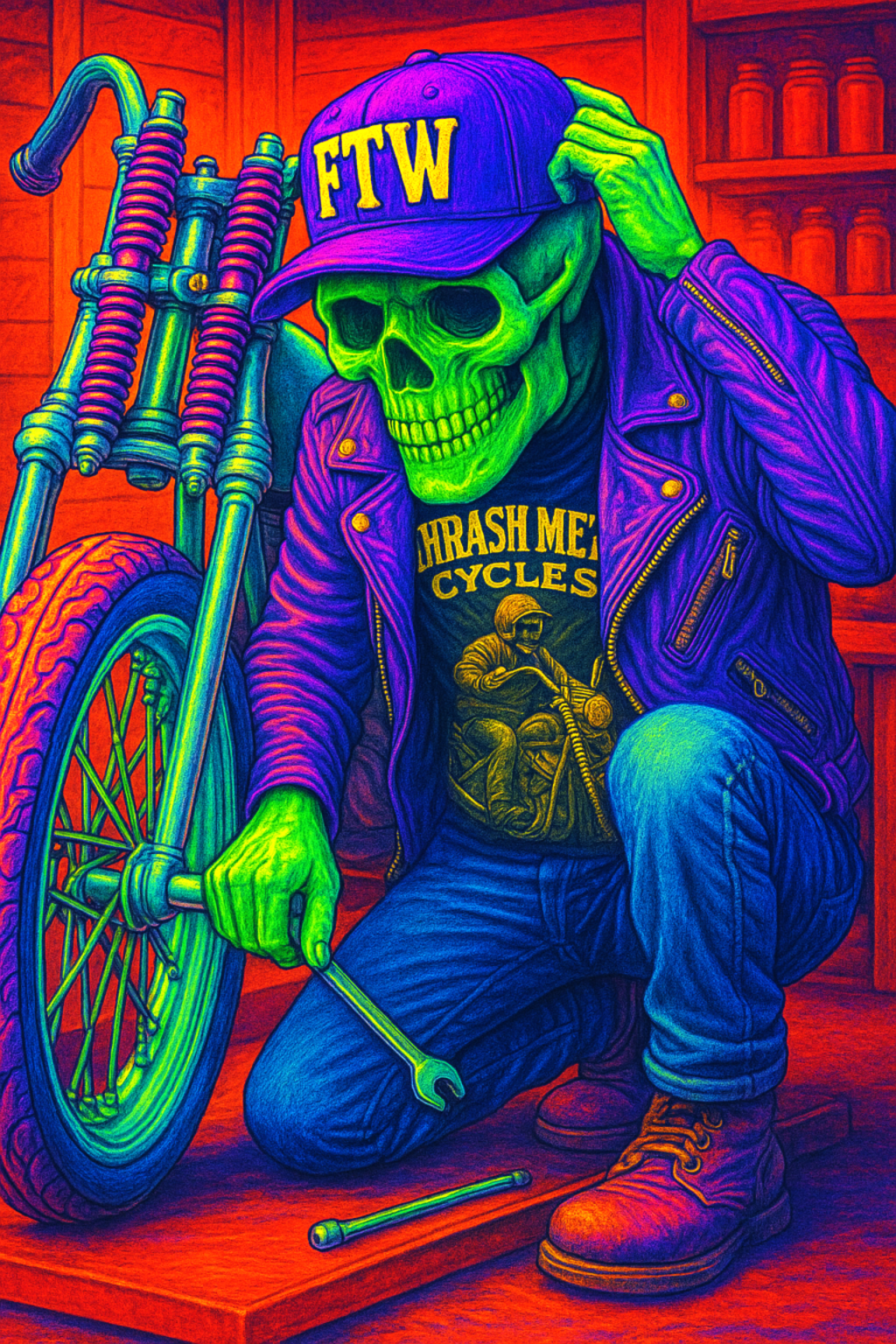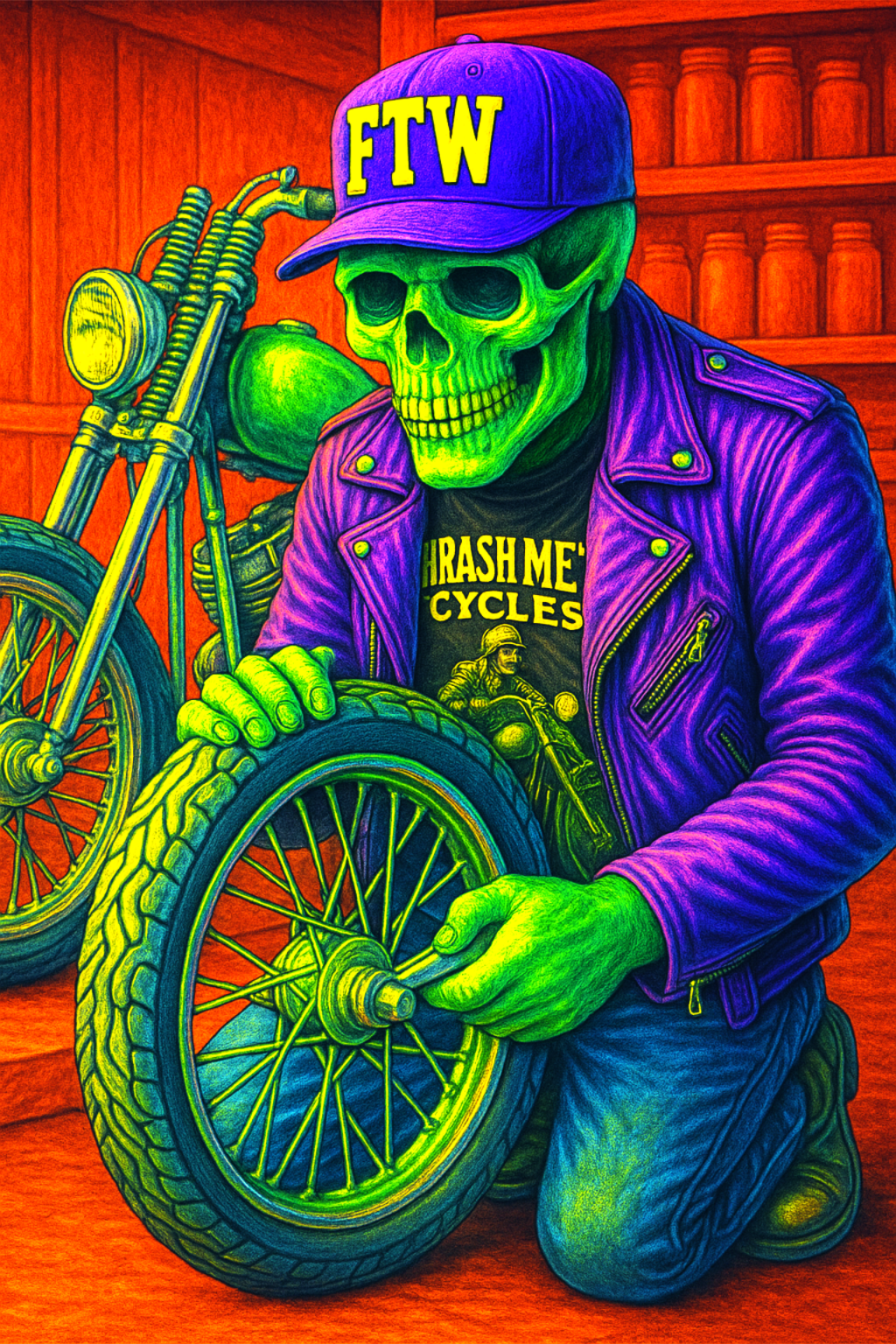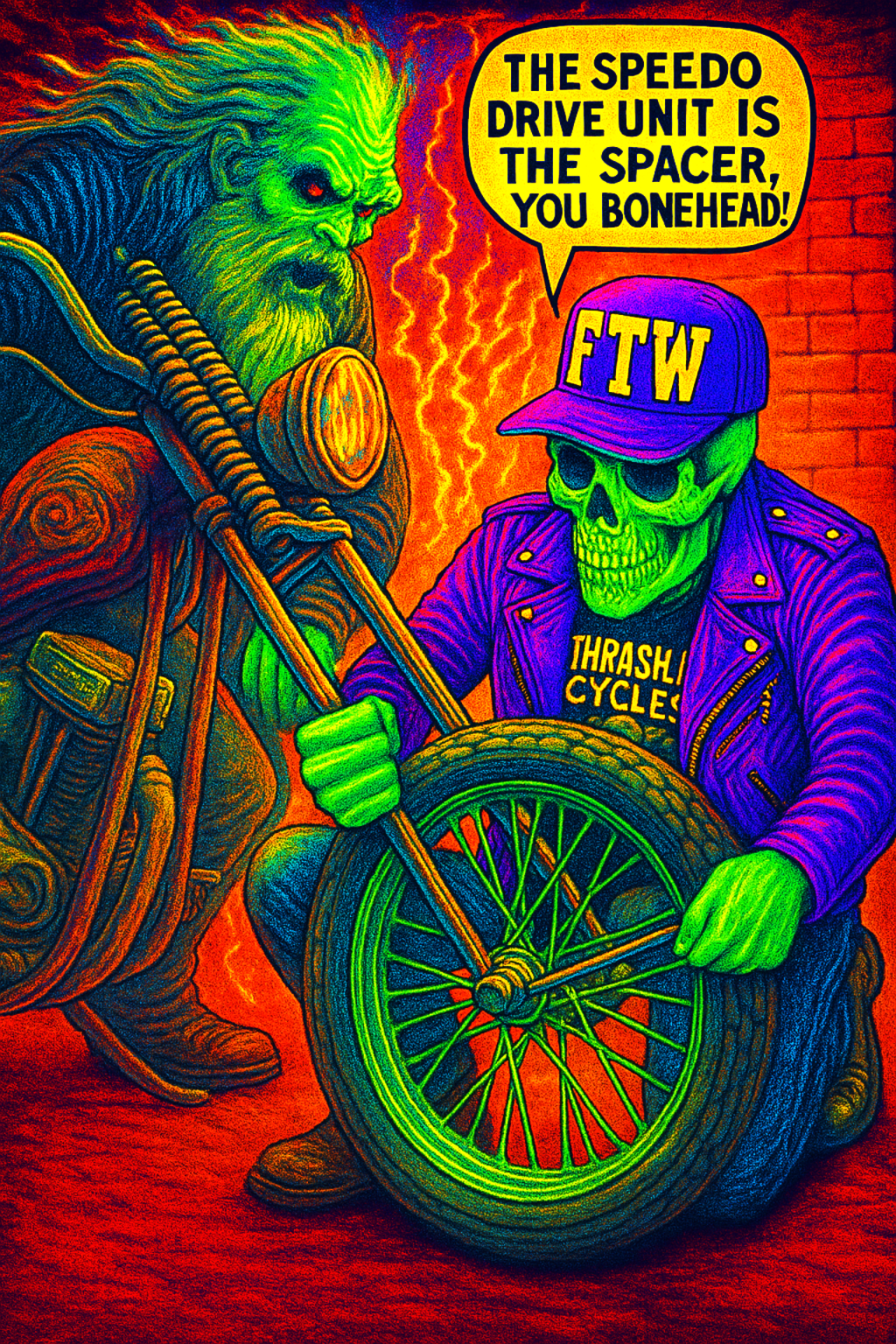THE HARLEY-DAVIDSON FRONT END
"Torque spec? Never heard of her. Herman’s going by feel and fire tonight."
THE HARLEY-DAVIDSON FRONT END
The front end of a Harley is more than just fork tubes and an axle—it’s the steering soul of the machine. Whether you’re building from scratch, trying to identify a mystery front end, or just upgrading the look and feel of your ride, understanding Harley front ends is mandatory. It’s also one of the most misunderstood areas, especially when mixing parts from different generations.
This guide breaks it all down, from Knuckle to Milwaukee-Eight, with every weird riser bolt, axle diameter, and neck stem in between.
Fork Family Tree
Over the years, Harley-Davidson has developed a few major front-end families. These include springers, Hydra-Glides, narrow glides, wide glides, and more modern variants. Each generation had its own riser setups, stem specs, axle sizes, and fork tube diameters. Understanding the differences is the key to building something that works—and won’t kill you at speed.
Springers came first. Then Hydra-Glides brought hydraulic damping in 1949. Bolt-on risers started appearing around 1958. Then came the FX series narrow glide in the 1970s, Showa forks in the ‘80s, 49mm beef on Twin Cams, and sealed bearings and metric bits on some M8s. Every one of these changes affects fitment.
Forks also shifted in their approach to damping and travel. The early springers had practically no dampening. The Hydra-Glides introduced internal damping rods but were still crude by today’s standards. By the time Showa took over production of Harley's forks in the '70s and '80s, things started to get more refined—but that also meant parts compatibility got more complicated.
Risers and Their Bolt Pattern
Almost all Harley risers since the late ‘50s use a 3.5-inch center-to-center bolt spacing, with 1/2”-20 fine thread bolts securing them to the top triple tree. That part’s simple—until it isn’t. Early Hydra-Glide trees (1949–1957) had cast-in risers, which means you can’t swap them out unless you replace the whole top tree. Once bolt-on risers came in around 1958, it became easier to mix and match.
But not everything follows the rules. Springer front ends have no top clamp riser holes. Instead, risers mount to the rear legs, often via threaded bungs or studs. Most modern springers use 1/2”-20 bolts and accept 1” bars—but spacing can vary. FXSTS and FLSTS springers tend to stick to 3.5", but don’t assume aftermarket springers will. Always measure.
A few Harley models, such as the Street 500/750 or drag-style configurations, use integrated bar clamps with no separate risers. Clean, yes. Modular, no. If your top tree doesn’t have riser holes, you’ll need to swap trees to run aftermarket risers.
Axle Sizing and Fitment
For decades, Harley used 3/4-inch axles. Easy. Simple. Compatible across tons of models. Then, around the early 2000s, things got spicy—25mm and 1-inch axles appeared on Touring bikes, Dynas, and some later Sportsters. It wasn’t just about axle diameter either. Bearings changed. Spacer thicknesses changed. The location of the brake rotor relative to the fork leg changed.
If you’re trying to swap a modern wheel into a vintage fork, or vice versa, you need to measure:
Axle diameter and length
Bearing I.D. and hub width
Spacer stack height
Rotor offset
If you don’t, you’ll end up with a caliper that doesn’t line up, a rotor that rubs, or a wheel that binds once torqued. And don’t forget—some aftermarket wheels use their own oddball bearings. Always check what’s actually in the hub.
Wheel Spacing: Glide Widths and the Domino Effect
Harley uses three main triple tree widths:
Narrow Glide: 7.00" center-to-center
Mid Glide: 8.437"
Wide Glide: 9.875"
Each of these directly impacts the axle length, hub width, rotor clearance, caliper position, and even fender options.
Mid glides became popular on bikes like the Forty-Eight, giving a bit more stance without the full wide glide look. Wide glides were traditionally found on FXWG models, Dynas, and Touring models with more aggressive stances. Narrow glides are tighter, nimble, and often seen on FXRs and Sportsters.
When you're swapping trees or legs, even a half-inch of misalignment can throw everything off. Rotors won’t match calipers. Tires won’t clear fenders. The bike could ride crooked. Always mock up your front end before powder-coating your parts or torquing down final hardware.
Neck Size and Stem Fitment: The Tripwire
Now we’re deep into the voodoo. Neck stem fitment isn’t just about diameter—it’s about bearing style, stem length, neck depth, and preload setup. Most Harleys use a 1” stem, but not all.
Pre-’81 Sportsters used 7/8" or 15/16" stems
Post-’82 Sportsters and Big Twins typically use 1" stems with Timken-style tapered bearings
Modern Touring and M8 Softails use longer stems with sealed bearings
Pan America and FXDR-style bikes? Expect metric madness
If your stem is too short, you can’t preload the bearings properly. Too long, and you won’t torque the top nut or the trees won’t clamp down right. If your neck bore doesn’t match your bearing size, nothing works.
The fix? Measure your neck bore and depth. Then either run conversion cups (like those from Vulcan Engineering or TC Bros), or machine a custom stem. Just don’t jam a 1-inch stem into a 7/8” neck and hope for the best.
The Sportster Front End: Slim but Complex
Sportsters are often viewed as easy to mod, but their front ends deserve a chapter of their own.
1957–1972: 33.4mm fork tubes, 7/8" or 15/16" neck stems, drum brakes, and usually integrated risers.
1973–1985: 35mm Kayaba and Showa forks. Introduced disc brakes. Riser spacing starts to standardize.
1986–2003: 39mm Showa Narrow Glide. 1” stem, 3/4” axle. Still the gold standard for chopped front ends.
2004–2015: 39mm forks remain, but fork internals change. Rubber mounts. Mid-glide spacing appears on select models.
2016–Present: 49mm forks on models like the Forty-Eight and Roadster. Bigger legs, sealed bearings, sometimes 25mm axles.
Want to adapt a 39mm Sporty fork to a Dyna? You can—but watch the caliper location. Brake mounts differ. Fork length varies. And hub width may need custom spacers.
Sportster trees (especially early ones) also sometimes differ in stem length and pinch bolt orientation. Another trap? Many Sporty forks are 1” shorter than Big Twin forks—affecting rake and trail on your chopper build.
Handling and Ride Feel
Not all front ends are created equal—even if they technically “fit.”
Springers ride rigid and twitchy unless properly tuned. They shine on light bikes and bobbers but can beat you up on highway rides. Wide Glide forks feel stable at speed but can slow down steering in tight turns. Narrow Glides are flickable and precise but may feel unstable when loaded or stretched out.
Fork diameter matters too:
33.4mm = ultra slim, drum brake era. Not much support for modern braking or weight.
35mm = early disc brake, decent on lightweight bikes.
39mm = reliable, adaptable, still used in many builds.
41mm = traditional wide glide strength.
49mm = modern performance, stiffer under braking, heavier stance.
The bigger the fork tube, the more stable the ride—especially under braking and in cornering transitions. But bigger also means heavier, which affects front-end feel, wheelbase, and rake.
Common Mistakes When Swapping Front Ends
Assuming riser spacing is universal
Using a modern rotor on an early hub
Not checking fork stop compatibility
Mixing sealed and Timken bearing parts without conversion cups
Over-torquing aluminum trees and stripping riser threads
Ignoring fork tube length differences that throw off ride height
If you’re unsure, take your parts to the bench. Measure. Compare. Mock-up before painting or plating. One wrong spacer can cost you a rotor, a fork seal, or worse—your front teeth.
Final Thoughts
Harley front ends aren’t black magic. But they are loaded with traps for the overconfident. You don’t need to memorize every part number—you just need to learn how to measure, mock-up, and cross-check before spending your paycheck on mismatched components.
Respect the riser spacing. Confirm the stem size. Know your glide width. Don't trust a parts seller who says “should fit” without giving you numbers.
Whether you’re building a greasy Panhead bobber, a Dyna club bike, or just fixing up your old Evo Sporty, the front end sets the tone—both in style and how it rides.
Measure twice. Thread softly. Shim it right. Then send it down the road.



